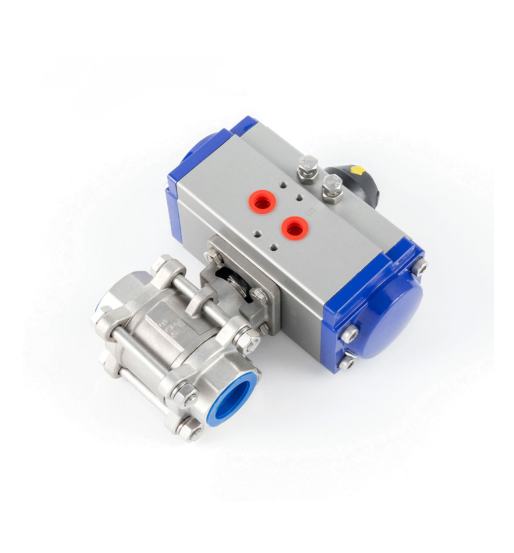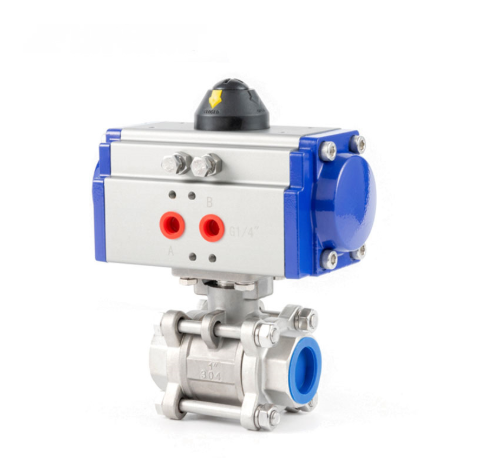
Pneumatic ball control valves are automated devices designed to regulate fluid flow by using compressed air or gas to actuate a ball mechanism within the valve. These valves play a pivotal role in a wide range of industries, offering precise control over the flow of liquids or gases. When actuated, the internal ball within the valve either blocks or permits fluid flow, depending on the valve's design. This dynamic functionality makes pneumatic ball valves highly customizable, providing versatility for applications that require accurate fluid flow regulation.
The valve body typically features a spherical sealing element that fits snugly into a seat with tight tolerances. This design ensures minimal leakage, reduces energy loss, and maximizes efficiency. Thanks to their modular design, pneumatic ball control valves are easily adaptable to various industrial systems, offering high-performance solutions for diverse fluid control needs. This article delves into the operation, key components, benefits, and various applications of pneumatic ball valves, highlighting their significance in modern control systems.
Pneumatic ball control valves rely on a simple yet highly effective mechanism. The design consists of a circular valve body with a hole in the center, and a rotating ball that also has a hole in it. When compressed air or gas is applied to the actuator, it moves the internal ball, causing its hole to align with the hole in the valve body, or it moves to a position where the hole is blocked, depending on the required flow condition.
This rotational movement of the ball within the valve body effectively controls the flow of fluid through the system. Pneumatic actuators, typically powered by compressed air, are responsible for rotating the ball to either the open or closed position, depending on the control signal received from the control system.
In essence, pneumatic ball valves operate as a "gate" that opens or closes in response to air pressure, providing a reliable and efficient solution for fluid flow regulation in industrial processes.

A pneumatic ball valve consists of two primary components: the ball and the actuator. Each component serves a specific function to ensure the smooth and precise operation of the valve.
The ball is often made of robust materials such as stainless steel, which ensures the valve can withstand high pressures and harsh conditions. The ball has a hole, which allows fluid to flow through the valve when aligned with the pipe opening. The ball is designed to rotate by 90 degrees, either blocking or enabling fluid flow, depending on its position.
The actuator is the component responsible for moving the ball. It is powered by compressed air or gas, which either expands or contracts the actuator mechanism. This movement drives the rotation of the ball, either opening or closing the valve. Actuators can be single-acting or double-acting, providing flexibility in valve control based on the application's requirements.
The valve body houses the ball and actuator and provides the structure necessary for fluid containment. The body is designed to be durable and resistant to corrosion, ensuring a long service life.
The seat is a critical component that ensures a tight seal between the ball and the valve body. High-quality seats, often made of materials like PTFE or other sealing compounds, are essential for minimizing leakage and maintaining pressure integrity. Seals also play an important role in ensuring the valve’s longevity by preventing fluid leaks.
Pneumatic ball valves operate with a straightforward mechanism but offer remarkable flexibility in controlling fluid flow. The process can be broken down into three main phases:
When the actuator receives a signal, it either expands or contracts due to the application of compressed air or gas. This movement causes the ball inside the valve to align with the pipe opening, allowing fluid to flow through the valve unobstructed.
The actuator’s movement rotates the ball by 90 degrees, changing the position of the ball from open to closed. The control system typically sends a signal to either open or close the valve as required by the specific application.
When the actuator has completed its movement, the ball rotates to a position where the hole in the ball is perpendicular to the hole in the valve body. This blocks the flow of fluid, stopping the passage of liquid or gas.
The entire operation cycle is quick, responsive, and highly reliable, making pneumatic ball valves ideal for applications that require immediate and accurate control over fluid flow.
Pneumatic ball valves are favored in many industries due to their numerous advantages, which make them an essential component for fluid control systems. Some of the key benefits include:
Pneumatic ball valves can open or close rapidly in response to control signals. This makes them ideal for applications that demand fast and precise control over fluid flow, such as in process industries, HVAC systems, and water treatment plants.
Pneumatic actuators are known for their dependability. By using compressed air, pneumatic ball valves are not susceptible to power failures or electrical issues, ensuring consistent performance in various industrial environments.
These valves feature fewer moving parts than other valve types, which leads to lower wear and tear, reduced maintenance costs, and greater reliability. Their simple design also makes them easier to install and service, which is crucial for minimizing downtime in industrial operations.
Made from materials like stainless steel or high-performance alloys, pneumatic ball valves are designed to withstand harsh environmental conditions, high pressures, and corrosive fluids. This durability ensures a long service life with minimal maintenance requirements.
Pneumatic ball valves can be customized to meet specific needs, such as incorporating specialized actuator designs, adding additional features like limit switches, or using different materials for the ball and seals to accommodate various fluid types and pressures.
Pneumatic ball valves are widely used across numerous industries, offering precise fluid control in a variety of demanding environments. Some key applications include:
Pneumatic ball valves are used extensively for regulating the flow of oil, gas, and chemicals in pipelines, refineries, and storage facilities. Their quick operation and ability to handle high pressures make them invaluable in these critical applications.
In chemical plants, precise fluid control is essential to prevent contamination and ensure safe, efficient processes. Pneumatic ball valves offer reliable shutoff capabilities, helping to maintain the integrity of the system.
Pneumatic ball valves play an important role in managing the flow of water and chemicals in treatment plants. They allow for rapid adjustments to flow, ensuring proper filtration and treatment procedures.
In heating, ventilation, and air conditioning (HVAC) systems, pneumatic ball valves are used to regulate the flow of air and fluids in ducts, chillers, and cooling towers. Their quick response time and reliable performance ensure optimal system efficiency.
Pneumatic ball valves are commonly used in the food and beverage industry for controlling the flow of liquids, gases, and slurries. Their ability to provide tight shutoff and avoid contamination makes them suitable for hygienic applications.
Pneumatic ball control valves are a fundamental component in modern industrial control systems, offering a simple yet effective solution for regulating fluid flow with precision and reliability. Their quick response, durability, and adaptability make them an ideal choice for applications across various sectors, including oil and gas, chemical processing, water treatment, HVAC, and food processing industries. By leveraging the advantages of compressed air, these valves provide consistent performance, low maintenance, and cost-effective operation, ensuring their continued importance in fluid control technologies.